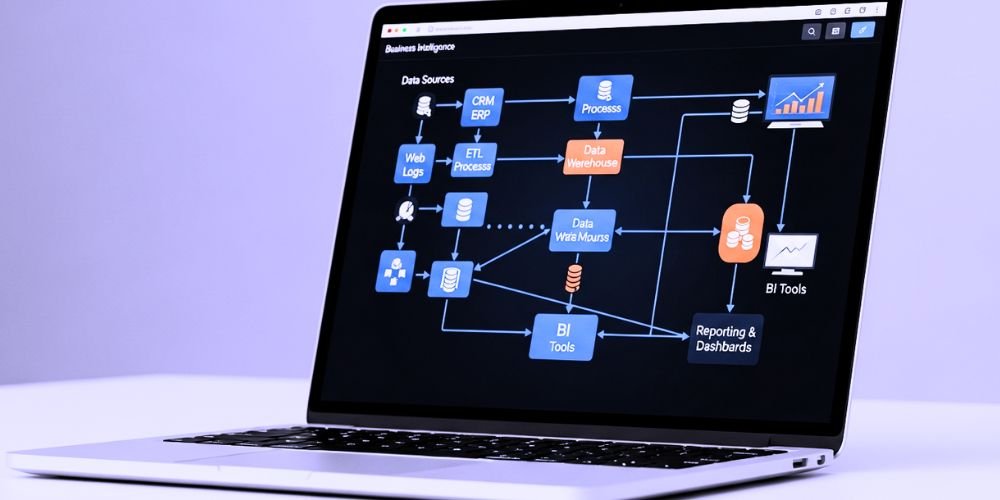In today’s data-driven business landscape, organizations rely on Business Intelligence (BI) to extract valuable insights and make informed decisions. However, the success of BI initiatives depends heavily on the underlying infrastructure that supports data storage, processing, and analysis. A robust Business Intelligence infrastructure forms the backbone of effective data-driven decision-making. This article explores the significance of a well-designed Business Intelligence Infrastructure, its key components, and the benefits it brings to organizations.
The Importance of Business Intelligence Infrastructure
A Business Intelligence infrastructure provides the foundation for organizations to leverage data effectively. It encompasses the hardware, software, networks, and processes that enable data collection, storage, integration, analysis, and visualization. Here’s why a solid Business Intelligence Infrastructure is crucial.
Data Management and Integration
A reliable Business Intelligence Infrastructure enables efficient data management and integration. It ensures that data is captured from various sources, cleansed, transformed, and stored in a centralized data repository. Robust data integration processes enable organizations to combine data from disparate systems and gain a holistic view of their operations.
Scalability and Performance
As organizations collect and analyze increasingly large volumes of data, scalability, and performance become critical. A well-designed Business Intelligence Infrastructure can scale seamlessly to accommodate growing data needs without sacrificing performance. It supports the efficient processing of queries, the generation of reports and dashboards, and the delivery of timely insights to users.
Data Security and Governance
Data security and governance are paramount in a BI environment. A robust infrastructure includes protecting data privacy, ensuring regulation compliance, and guarding against unauthorized access or data breaches. It incorporates authentication, encryption, access controls, and audit trails to safeguard sensitive information and maintain data integrity.
Seamless Data Integration with External Systems
A Business Intelligence infrastructure facilitates seamless integration with external systems and data sources. It enables organizations to incorporate external data, such as market trends, customer data, or industry benchmarks, into their analyses. This integration enhances the depth and accuracy of insights, enabling organizations to make more informed decisions.
Key Components of a Business Intelligence Infrastructure
A solid business intelligence infrastructure is crucial when optimizing a company’s decision-making process. The key components of such an infrastructure include a reliable data source, a powerful analytics engine, and an intuitive dashboard interface.
Data Storage and Management
A Business Intelligence Infrastructure includes a data storage component capable of handling large volumes of structured and unstructured data. It may involve a data warehouse, data lakes, or cloud-based storage solutions. It also incorporates data management tools and processes to ensure data quality, consistency, and accessibility.
ETL (Extract, Transform, Load) Processes
ETL processes are integral to a Business Intelligence Infrastructure. They involve extracting data from various sources, transforming it into a standardized format, and loading it into the data repository. ETL tools automate these processes, ensuring efficient and accurate data integration.
Data Integration and Middleware
Data integration and middleware components enable the smooth flow of data between systems. They facilitate data exchange across different platforms, databases, and applications, ensuring compatibility and seamless integration. These components connect disparate data sources and enable real-time or near-real-time data availability.
Analytical Tools and Reporting
The Business Intelligence Infrastructure incorporates analytical tools and reporting capabilities. These tools enable users to explore, analyze, and visualize data, uncover insights, and generate reports and dashboards. From data visualization tools to advanced analytics platforms, these components empower users to make data-driven decisions.
Metadata Management
Metadata management is a crucial component of a Business Intelligence Infrastructure. It involves capturing and managing metadata, which provides information about the data’s structure, meaning, and context. Effective metadata management ensures data consistency, accuracy, and traceability, enabling users to understand and trust the data they are working with.
Benefits of a Robust Business Intelligence Infrastructure
A robust business intelligence infrastructure can provide numerous benefits to a company, including improved decision-making, increased efficiency, and a deeper understanding of their business and industry.
Data-Driven Decision-Making
A well-designed Business Intelligence Infrastructure provides timely, accurate, and relevant data, empowering organizations to make informed decisions. It enables users to access and analyze data efficiently, generating insights that drive strategic planning, operational improvements, and competitive advantages.
Enhanced Operational Efficiency
A robust Business Intelligence Infrastructure enhances operational efficiency by streamlining data integration, storage, and analysis. It eliminates manual data processing tasks, reduces errors, and automates reporting, enabling users to focus on data interpretation and value-added activities.
Scalability and Future-Proofing
A solid Business Intelligence Infrastructure is scalable and adaptable to evolving business needs. It can accommodate growing data volumes, integrate new data sources, and support emerging technologies. By investing in a scalable infrastructure, organizations future-proof their BI capabilities and avoid costly infrastructure redesigns.
Improved Collaboration and Data Governance
An effective Business Intelligence Infrastructure promotes collaboration and data governance. It provides a centralized and secure data repository, ensuring that users have access to consistent, reliable data. It fosters trust, promotes collaboration, and aligns data definitions and usage across the organization.
Competitive Advantage
A well-implemented Business Intelligence Infrastructure can provide a competitive advantage. By leveraging data effectively, organizations can identify trends, uncover hidden insights, and make proactive decisions. It enables them to respond quickly to market changes, identify new opportunities, and stay ahead of the competition.
Conclusion
A robust Business Intelligence infrastructure forms the backbone of effective data-driven decision-making. Organizations can unlock the full possibility of their data by providing scalable data storage, seamless integration, analytical tools, and robust security measures. A well-designed infrastructure enhances operational efficiency, promotes collaboration, ensures data governance, and empowers organizations to gain a competitive edge in a data-rich business landscape. By investing in a solid BI infrastructure, organizations lay the foundation for success in data-driven insights and decision-making.













